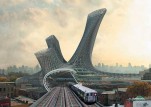Life over the Highway

In modern cities is quite difficult to find space for the construction of new residential and office buildings. Experts from the architectural bureau AMLGM Chad Kellogg (Chad Kellogg) and Matt Bowles (Matt Bowles) proposed for this space over major highways. They envisioned a new residential tower typology for New York that can connect and transform unused space surrounding various transportation hubs into a dense, mixed-use housing tower.
The proposal, dubbed Urban Alloy, which won first in Metropolis’ Living Cities Residential Tower Competition and received honorable mention in Evolo Skyscrapers 2014. The project is capable of responding to a number of unique spacial and environmental situations, providing a new way for the city to grow “organically” and provide adequate housing for the expanding population.
The project proposes habitable spaces in leftover sites surrounding transportation intersections, such as elevated train lines and freeways. Wanting to optimize a heterogeneous and highly linked set of living environments, the concept uses specified materials and makes the most of being positioned above these set systems. The design offers an alternative to current urban renewal based modes of densification through an exploration of symbiotic re-purposing of air rights above transportation existing corridors in New York.
Urban Alloy proposes a residential typology rooted in the remnant spaces surrounding the intersection of transportation infrastructure, such as elevated train lines and freeway interchanges. Entwining them, like an octopus, a house not only saves space, but also construction materials. This unusual building is a tubular structure made of remelted rails. With the proposed design and specified materials, the project aimed to optimize a heterogeneous and highly linked set of living environments capturing the air rights above these systems.
Concept
The most dynamic cities of the 21st century, such as New York, are anthropomorphic alloys that act as engines for innovation and social cohesion. These cities, with their continually evolving demographics, will forge the dynamic societies of the future. With the rapid rise of near instantaneous communication, a city’s’ livability has gained prominence as an attractor for top minds. In order to secure its future as the leading global center, New York needs to continue to grow in smart ways. We see the opportunity to draw the energy of Manhattan out into the four other boroughs without disrupting existing land use.
Urban Alloy proposes a residential typology rooted in the remnant spaces surrounding the intersection of transportation infrastructure, such as elevated train lines and freeway interchanges. With the proposed design and specified materials, we aim to optimize a heterogeneous and highly linked set of living environments capturing the air rights above these systems.
Full content of this issue you can read here
The full version of the article can be read in our printed issue, also you can subscribe to the web-version of the magazine
 Materials provided by eVolo Magazine
Materials provided by eVolo Magazine


